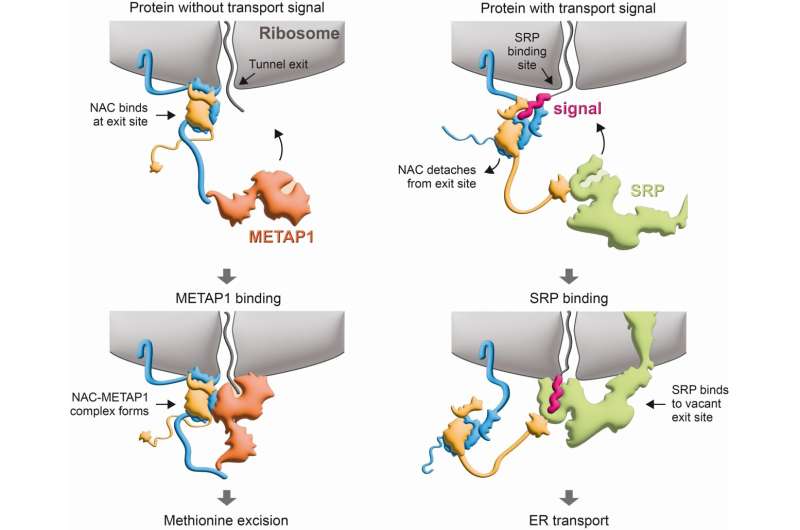This article has been reviewed according to Science X's editorial process and policies. Editors have highlighted the following attributes while ensuring the content's credibility:
fact-checked
peer-reviewed publication
trusted source
proofread
Ribosomal gatekeepers: Study sheds light on molecular control centers of eukaryote protein factories

Based on genetic blueprints, individual amino acids are assembled into long amino acid chains, the proteins, in the protein factories of our cells, the ribosomes. Each newly formed protein starts with the amino acid methionine. This amino acid is often split off again during protein synthesis, as soon as the growing amino acid chain leaves the protein factory through the "ribosomal tunnel." In these cases, the excision of methionine is essential to ensure the subsequent function of the corresponding proteins in the cell.
The enzymes causing this cleavage are already known. According to their function, they are called methionine aminopeptidases (METAPs). Up to now, it was unclear how METAPs come into contact with the protein factories and, just at the right place and moment, cause the excision of methionine from specific proteins. Biologists Elke Deuerling, Martin Gamerdinger and their team from the University of Konstanz (Germany), together with Nenad Ban and his colleagues from ETH Zurich (Switzerland), have now shed light on the subject. The results published in Science show: access of METAPs to protein factories is controlled by a "ribosomal gatekeeper" called NAC (short for "nascent polypeptide-associated complex").
More extensive function than previously known
Only last year (2022), the team led by Deuerling and Gamerdinger was able to elucidate that NAC performs an important sorting function at the ribosomal tunnel. "We were able to show that NAC sits in front of the tunnel exit like a gatekeeper. There it controls the transport of proteins to the endoplasmic reticulum (ER)—the membrane network inside the cell—by specifically bringing together protein and transport molecule (SRP)," Deuerling said, summarizing the previous study results.
In their new study, the researchers now show that the gatekeeper's sorting function is more extensive and even more significant than previously known, and that NAC also ensures the correct methionine excision from nascent proteins.
In proteins transported to the ER, the first amino acid methionine is part of a transport signal. "Methionine excision in these proteins would destroy the signal and thus prevent its transport into the cell's membrane network, which would inevitably lead to cell death," Gamerdinger explains. How these transport signals are prevented from being destroyed by METAPs was a major scientific puzzle the scientists from Konstanz and Zurich have now solved: The gatekeeper NAC forms a complex with METAP1 and the ribosome at the exit of the ribosomal tunnel. Only within this complex can the enzyme cause the excision of methionine from newly formed proteins.
This changes as soon as a protein with a transport signal leaves the ribosomal tunnel. Interactions between the protein's signal sequence and NAC then cause the gatekeeper to change its own position at the ribosomal tunnel. As a result, METAP1 loses its binding to NAC and thus its ability to cleave off methionine. With the changed position of the gatekeeper, a new binding interface becomes accessible for the transport molecule SRP. "This mechanism means that proteins lacking signal sequences can be specifically modified by methionine excision. Those, in contrast, that are transported to the endoplasmic reticulum, remain unaffected by METAP1," Gamerdinger explains.
The gatekeeper as a mediation all-rounder?
The researchers hypothesize that NAC may have other similar mediating functions at the ribosomal tunnel, thus assuming the role of a general molecular control center.
"There is a large number of enzymes and transport molecules that, like METAP1 and SRP, interact with the nascent proteins already during protein synthesis. Future studies will therefore have to show whether NAC also plays a role in regulating other processes that are vital for the function of our cells," says Deuerling.
More information: Martin Gamerdinger et al, NAC controls cotranslational N-terminal methionine excision in eukaryotes, Science (2023). DOI: 10.1126/science.adg3297. www.science.org/doi/10.1126/science.adg3297
Journal information: Science
Provided by University of Konstanz


















